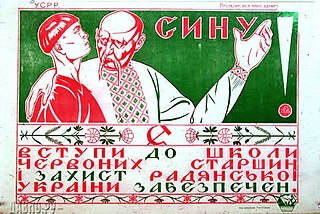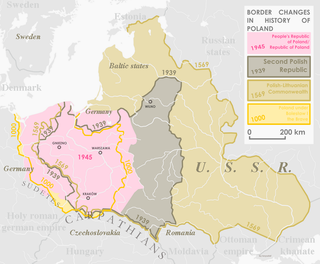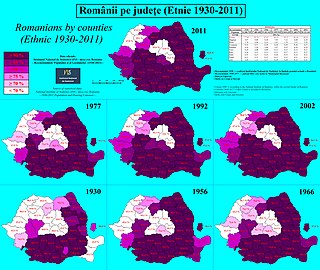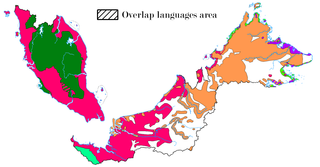Related Research Articles
Language policy is both an interdisciplinary academic field and implementation of ideas about language use. Some scholars such as Joshua Fishman and Ofelia García consider it as part of sociolinguistics. On the other hand, other scholars such as Bernard Spolsky, Robert B. Kaplan and Joseph Lo Bianco argue that language policy is a branch of applied linguistics.

Lemkos are an ethnic group inhabiting the Lemko Region of Carpathian Rus', an ethnographic region in the Carpathian Mountains and foothills spanning Ukraine, Slovakia and Poland.

Russification, or Russianization, is a form of cultural assimilation in which non-Russians, whether involuntarily or voluntarily, give up their culture and language in favor of the Russian culture and the Russian language.
Germanisation, or Germanization, is the spread of the German language, people, and culture. It was a central idea of German conservative thought in the 19th and the 20th centuries, when conservatism and ethnic nationalism went hand in hand. In linguistics, Germanisation of non-German languages also occurs when they adopt many German words.

Korenizatsiia was an early policy of the Soviet Union for the integration of non-Russian nationalities into the governments of their specific Soviet republics. In the 1920s, the policy promoted representatives of the titular nation, and their national minorities, into the lower administrative levels of the local government, bureaucracy, and nomenklatura of their Soviet republics. The main idea of the korenizatsiia was to grow communist cadres for every nationality. In Russian, the term korenizatsiya (коренизация) derives from korennoye naseleniye. The policy practically ended in the mid-1930s with the deportations of various nationalities.
A minority language is a language spoken by a minority of the population of a territory. Such people are termed linguistic minorities or language minorities. With a total number of 196 sovereign states recognized internationally and an estimated number of roughly 5,000 to 7,000 languages spoken worldwide, the vast majority of languages are minority languages in every country in which they are spoken. Some minority languages are simultaneously also official languages, such as Irish in Ireland or the numerous indigenous languages of Bolivia. Likewise, some national languages are often considered minority languages, insofar as they are the national language of a stateless nation.
A medium of instruction is a language used in teaching. It may or may not be the official language of the country or territory. If the first language of students is different from the official language, it may be used as the medium of instruction for part or all of schooling. Bilingual education or multilingual education may involve the use of more than one language of instruction. UNESCO considers that "providing education in a child's mother tongue is indeed a critical issue". In post-secondary, university and special education settings, content may often be taught in a language that is not spoken in the students' homes. This is referred to as content based learning or content and language integrated learning (CLIL). In situations where the medium of instruction of academic disciplines is English when it is not the students' first language, the phenomenon is referred to as English-medium instruction (EMI).

Polonization is the acquisition or imposition of elements of Polish culture, in particular the Polish language. This happened in some historic periods among non-Polish populations in territories controlled by or substantially under the influence of Poland.

Hungarian irredentism or Greater Hungary are irredentist political ideas concerning redemption of territories of the historical Kingdom of Hungary. Targeting at least to regain control over Hungarian-populated areas in Hungary's neighbouring countries. Hungarian historiography uses the term "Historic Hungary". "Whole Hungary" is also commonly used by supporters of this ideology.

Ukrainization is a policy or practice of increasing the usage and facilitating the development of the Ukrainian language and promoting other elements of Ukrainian culture in various spheres of public life such as education, publishing, government, and religion. The term is also used to describe a process by which non-Ukrainians or Russian-speaking Ukrainians are assimilated to Ukrainian culture and language.

Romanianization is the series of policies aimed toward ethnic assimilation implemented by the Romanian authorities during the 20th and 21st century. The most noteworthy policies were those aimed at the Hungarian minority in Romania, Jews and as well the Ukrainian minority in Bukovina and Bessarabia.
Canadian Ukrainian is a dialect of the Ukrainian language specific to the Ukrainian Canadian community descended from the first three waves of historical Ukrainian emigration to Western Canada. Canadian Ukrainian was widely spoken from the beginning of Ukrainian settlement in Canada in 1892 until the mid-20th century, when the number of its speakers started gradually declining.

Slovakization or Slovakisation is a form of either forced or voluntary cultural assimilation, during which non-Slovak nationals give up their culture and language in favor of the Slovak one. This process has relied most heavily on intimidation and harassment by state authorities. In the past the process has been greatly aided by deprivation of collective rights for minorities and ethnic cleansing, but in the last decades its promotion has been limited to the adoption of anti-minority policies and anti-minority hate speech.
Carinthian Slovenes or Carinthian Slovenians are the indigenous minority of Slovene ethnicity, living within borders of the Austrian state of Carinthia, neighboring Slovenia. Their status of the minority group is guaranteed in principle by the Constitution of Austria and under international law, and have seats in the National Ethnic Groups Advisory Council.

The indigenous languages of Malaysia belong to the Mon-Khmer and Malayo-Polynesian families. The national, or official, language is Malay which is the mother tongue of the majority Malay ethnic group. The main ethnic groups within Malaysia are the Malay people, Han Chinese people and Tamil people, with many other ethnic groups represented in smaller numbers, each with its own languages. The largest native languages spoken in East Malaysia are the Iban, Dusunic, and Kadazan languages. English is widely understood and spoken within the urban areas of the country; the English language is a compulsory subject in primary and secondary education. It is also the main medium of instruction within most private colleges and private universities. English may take precedence over Malay in certain official contexts as provided for by the National Language Act, especially in the states of Sabah and Sarawak, where it may be the official working language. Furthermore, the law of Malaysia is commonly taught and read in English, as the unwritten laws of Malaysia continues to be partially derived from pre-1957 English common law, which is a legacy of past British colonisation of the constituents forming Malaysia. In addition, authoritative versions of constitutional law and statutory law are continuously available in both Malay and English.

The Polish minority in Ukraine officially numbers about 144,130, of whom 21,094 (14.6%) speak Polish as their first language. The history of Polish settlement in current territory of Ukraine dates back to 1030–31. In Late Middle Ages, following the extinction of the Rurik dynasty in 1323, the Kingdom of Poland extended east in 1340 to include the lands of Przemyśl and in 1366, Kamianets-Podilskyi. The settlement of Poles became common there after the Polish–Lithuanian peace treaty signed in 1366 between Casimir III the Great of Poland, and Liubartas of Lithuania.

The history of the Ukrainian minority in Poland dates back to the Late Middle Ages, preceding the 14th century Galicia–Volhynia Wars between Casimir III the Great of Poland, and Liubartas of Lithuania. Following the extinction of the Rurikid dynasty in 1323, the Polish Kingdom extended further east in 1340 to include the lands of Przemyśl and in 1366, Kamianets-Podilskyi. After the Union of Lublin (1569), principalities of Galicia and Western Volhynia became, what is known as, the Ruthenian Voivodeship of the Polish Crown, while the rest of Red Ruthenia together with Kyiv came under Lithuanian control. The Polish borders reached as far east as Zaporizhia, and Poltava.

The Polish census of 1931 or Second General Census in Poland was the second census taken in sovereign Poland during the interwar period, performed on December 9, 1931 by the Main Bureau of Statistics. It established that Poland's population amounted to almost 32 million people.
Heritage language learning, or heritage language acquisition, is the act of learning a heritage language from an ethnolinguistic group that traditionally speaks the language, or from those whose family historically spoke the language. According to a commonly accepted definition by Valdés, heritage languages are generally minority languages in society and are typically learned at home during childhood. When a heritage language learner grows up in an environment with a dominant language that is different from their heritage language, the learner appears to be more competent in the dominant language and often feels more comfortable speaking in that language. "Heritage language" may also be referred to as "community language", "home language", and "ancestral language".
The following is a list of bilingual education by country or region.
References
- ↑ Timothy Snyder, The Reconstruction of Nations: Poland, Ukraine, Lithuania, Belarus, 1569-1999, Yale University Press, ISBN 0-300-10586-X, Google Books, p.144
- ↑ Heinz Dieter Pohl, Die ethnisch-sprachlichen Voraussetzungen der Volksabstimmung (Accessed on 3 August 2006)
- ↑ Isaac Landman (1939) The Universal Jewish Encyclopedia , p. 636: "Utraquist Schools"
- 1 2 Fudge, Thomas A. (2018-03-29). The Magnificent Ride: The First Reformation in Hussite Bohemia. Routledge. ISBN 9781351886338.
- ↑ Wolf, Michaela (2015). The Habsburg Monarchy's Many-Languaged Soul: Translating and interpreting, 1848–1918. Amsterdam: John Benjamins Publishing Company. p. 28. ISBN 9789027258564.
- 1 2 Thije, Jan D. ten; Zeevaert, Ludger (2007). Receptive Multilingualism: Linguistic Analyses, Language Policies, and Didactic Concepts. Philadelphia, PA: John Benjamins Publishing. p. 58. ISBN 9789027219268.